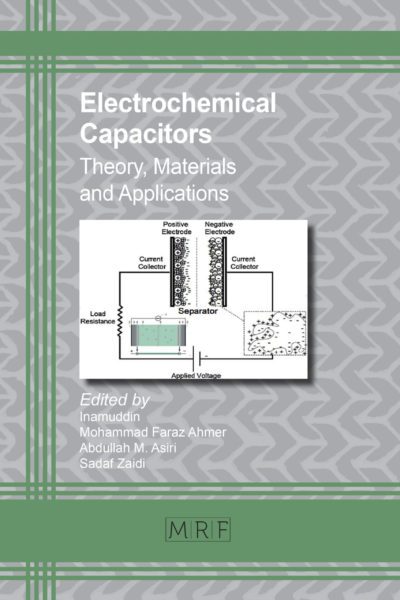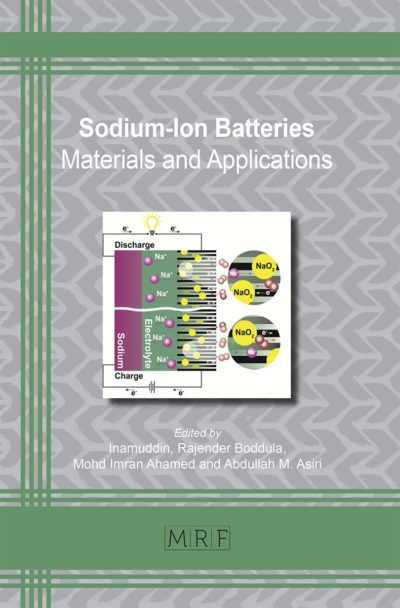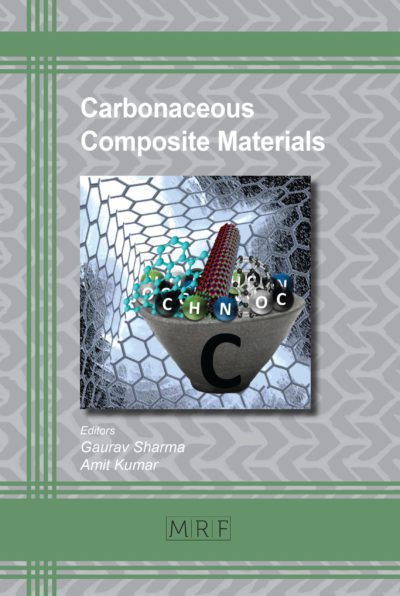Preparation of NiCu-PANI/N-rGO nanocomposite for hybrid supercapacitor
RAHMAN Mohammad Obaidur, M NOR Nursyarizal B, ROMLIE Mohd Fakhizan, SAKIDIN Hamzah, SAMSUDIN Dafrizal, MOHD KASIM Abdul Rahman, ADYTIA Didit, KANNAN Ramani
Abstract. A highly efficient nickel/copper oxide-PANI grafted nitrogen-doped reduced graphene oxide (NiCu-PANI/N-rGO) nanocomposite electrode material was developed for hybrid supercapacitors (HSCs). The prepared HSC achieved an excellent specific capacitance of 290 F g−1 at the current density of 1.5 A g−1. The rate capability of the device was recorded as 37% at 10 A g−1 current density and the calculated energy density was also recorded as 32.6 W h kg−1 at the power density of 670 kW kg−1. After 8000 charge-discharge cycles in the KOH electrolyte solution, an excellent capacitance retention (82%) was realized. These findings effectively illustrated the possible uses of the manufactured hybrid supercapacitor to mitigate upcoming energy demands.
Keywords
Hybrid Supercapacitor, Nanocomposite, Solvothermal Synthesis, Polyaniline, Heteroatom Doping, Graphene
Published online 4/25/2025, 10 pages
Copyright © 2025 by the author(s)
Published under license by Materials Research Forum LLC., Millersville PA, USA
Citation: RAHMAN Mohammad Obaidur, M NOR Nursyarizal B, ROMLIE Mohd Fakhizan, SAKIDIN Hamzah, SAMSUDIN Dafrizal, MOHD KASIM Abdul Rahman, ADYTIA Didit, KANNAN Ramani, Preparation of NiCu-PANI/N-rGO nanocomposite for hybrid supercapacitor, Materials Research Proceedings, Vol. 53, pp 198-207, 2025
DOI: https://doi.org/10.21741/9781644903575-19
The article was published as article 19 of the book Decarbonization Technology
![]() Content from this work may be used under the terms of the Creative Commons Attribution 3.0 license. Any further distribution of this work must maintain attribution to the author(s) and the title of the work, journal citation and DOI.
Content from this work may be used under the terms of the Creative Commons Attribution 3.0 license. Any further distribution of this work must maintain attribution to the author(s) and the title of the work, journal citation and DOI.
References
[1] R. Kötz and M. Carlen, “Principles and applications of electrochemical capacitors,” Electrochim. Acta, vol. 45, no. 15, pp. 2483-2498, 2000/05/03/ 2000, doi: https://doi.org/10.1016/S0013-4686(00)00354-6.
[2] V. K. Mariappan, K. Krishnamoorthy, P. Pazhamalai, S. Sahoo, S. S. Nardekar, and S.-J. Kim, “Nanostructured ternary metal chalcogenide-based binder-free electrodes for high energy density asymmetric supercapacitors,” Nano Energy, vol. 57, pp. 307-316, 2019/03/01/ 2019, doi: https://doi.org/10.1016/j.nanoen.2018.12.031.
[3] A. González, E. Goikolea, J. A. Barrena, and R. Mysyk, “Review on supercapacitors: Technologies and materials,” Ren. & Sus. Eng. Rev., vol. 58, pp. 1189-1206, 2016/05/01/ 2016, doi: https://doi.org/10.1016/j.rser.2015.12.249.
[4] M. Tomy, A. Ambika Rajappan, V. Vm, and X. Thankappan Suryabai, “Emergence of Novel 2D Materials for High-Performance Supercapacitor Electrode Applications: A Brief Review,” Energy & Fuels, vol. 35, no. 24, pp. 19881-19900, 2021/12/16 2021, doi: 10.1021/acs.energyfuels.1c02743.
[5] Z. S. Iro, C. Subramani, and S. Dash, “A brief review on electrode materials for supercapacitor,” Int. J. Electrochem. Sci, vol. 11, no. 12, pp. 10628-10643, 2016.
[6] H. Liu, X. Liu, S. Wang, H.-K. Liu, and L. Li, “Transition metal based battery-type electrodes in hybrid supercapacitors: A review,” Energy Storage Materials, vol. 28, pp. 122-145, 2020.
[7] C.-y. Hui, C.-w. Kan, C.-l. Mak, and K.-h. Chau, “Flexible energy storage system—an introductory review of textile-based flexible supercapacitors,” Processes, vol. 7, no. 12, p. 922, 2019.
[8] P. Forouzandeh, V. Kumaravel, and S. C. Pillai, “Electrode Materials for Supercapacitors: A Review of Recent Advances,” Catalysts, vol. 10, no. 9, p. 969, 2020. [Online]. Available: https://www.mdpi.com/2073-4344/10/9/969.
[9] Y. Zhu et al., “Graphene and graphene oxide: synthesis, properties, and applications,” Adv. Mater., vol. 22, no. 35, pp. 3906-3924, 2010.
[10] K. S. Novoselov et al., “Two-dimensional gas of massless Dirac fermions in graphene,” nature, vol. 438, no. 7065, pp. 197-200, 2005.
[11] Y. Liu, Y. Zhang, G. Ma, Z. Wang, K. Liu, and H. Liu, “Ethylene glycol reduced graphene oxide/polypyrrole composite for supercapacitor,” Electrochim. Acta, vol. 88, pp. 519-525, 2013/01/15/ 2013, doi: https://doi.org/10.1016/j.electacta.2012.10.082.
[12] W. Fan, Y.-Y. Xia, W. W. Tjiu, P. K. Pallathadka, C. He, and T. Liu, “Nitrogen-doped graphene hollow nanospheres as novel electrode materials for supercapacitor applications,” J. Power Sources, vol. 243, pp. 973-981, 2013.
[13] H. Lei, J. Tu, D. Tian, and S. Jiao, “A nitrogen-doped graphene cathode for high-capacitance aluminum-ion hybrid supercapacitors,” New J. Chem., vol. 42, no. 19, pp. 15684-15691, 2018.
[14] W. Raza et al., “Recent advancements in supercapacitor technology,” Nano Energy, vol. 52, pp. 441-473, 2018.
[15] H. S. Yaddanapudi, K. Tian, S. Teng, and A. Tiwari, “Facile preparation of nickel/carbonized wood nanocomposite for environmentally friendly supercapacitor electrodes,” Scientific Reports, vol. 6, no. 1, p. 33659, 2016.
[16] T. E. Balaji, H. Tanaya Das, and T. Maiyalagan, “Recent Trends in Bimetallic Oxides and Their Composites as Electrode Materials for Supercapacitor Applications,” ChemElectroChem, vol. 8, no. 10, pp. 1723-1746, 2021/05/11 2021, doi: https://doi.org/10.1002/celc.202100098.
[17] M. Yewale et al., “Sphere-Shaped CuCo2O4 Nanostructures battery type electrode for supercapacitor via Hydrothermal Synthesis Approach,” Colloids and Surfaces A: Physicochemical and Engineering Aspects, p. 132541, 2023.
[18] L. Chen, H. Xu, H. Cui, H. Zhou, H. Wan, and J. Chen, “Preparation of Cu–Ni bimetallic nanoparticles surface-capped with dodecanethiol and their tribological properties as lubricant additive,” Particuology, vol. 34, pp. 89-96, 2017/10/01/ 2017, doi: https://doi.org/10.1016/j.partic.2016.12.006.
[19] M. O. Rahman et al., “One-Step Solvothermal Synthesis by Ethylene Glycol to Produce N-rGO for Supercapacitor Applications,” Nanomaterials, vol. 13, no. 4, doi: 10.3390/nano13040666.
[20] M. O. Rahman et al., “One-Step Solvothermal Synthesis by Ethylene Glycol to Produce N-rGO for Supercapacitor Applications,” Nanomaterials, vol. 13, no. 4, p. 666, 2023. [Online]. Available: https://www.mdpi.com/2079-4991/13/4/666.
[21] S. V. Mulik, S. A. Jadhav, P. S. Patil, and S. D. Delekar, “4 – Transition metal oxide–conducting polymer nanocomposites and metal-organic framework-based composites for supercapacitor application,” in Advances in Metal Oxides and Their Composites for Emerging Applications, S. D. Delekar Ed.: Elsevier, 2022, pp. 135-185.
[22] M. Shoeb, M. Mobin, M. A. Rauf, S. M. Adnan, and M. Y. Ansari, “Graphene nickelcopper nanocomposite (Gr@ NiCu NCs) as a binder free electrode for high energy density supercapacitor and antimicrobial application,” Journal of Materiomics, vol. 7, no. 4, pp. 815-827, 2021.
[23] Z.-F. Li, H. Zhang, Q. Liu, Y. Liu, L. Stanciu, and J. Xie, “Covalently-grafted polyaniline on graphene oxide sheets for high performance electrochemical supercapacitors,” Carbon, vol. 71, pp. 257-267, 2014.
[24] Y. Zhu, W. Peng, Y. Li, G. Zhang, F. Zhang, and X. Fan, “Multiple roles of a heterointerface in two-dimensional van der Waals heterostructures: insights into energy-related applications,” J of Mater. Chem. A, vol. 7, no. 41, pp. 23577-23603, 2019.
[25] H. Siddiqui, M. R. Parra, M. S. Qureshi, M. M. Malik, and F. Z. Haque, “Studies of structural, optical, and electrical properties associated with defects in sodium-doped copper oxide (CuO/Na) nanostructures,” Journal of Materials Science, vol. 53, no. 12, pp. 8826-8843, 2018/06/01 2018, doi: 10.1007/s10853-018-2179-6.
[26] S. Sravya, D. RamaDevi, N. Belachew, K. E. Rao, and K. Basavaiah, “Vitamin C assisted synthesis of rGO–Ag/PANI nanocomposites for improved photocatalytic degradation of pharmaceutical wastes,” RSC advances, vol. 11, no. 20, pp. 12030-12035, 2021.
[27] D. Luan et al., “Fabrication and electrochemical properties of graphene/copper–nickel solid solution reinforced polyaniline composite,” Journal of Materials Science: Materials in Electronics, vol. 28, no. 19, pp. 14738-14746, 2017/10/01 2017, doi: 10.1007/s10854-017-7342-3.
[28] R. Wang et al., “Flexible ultrathin all-solid-state supercapacitors,” Rare Metals, vol. 37, pp. 536-542, 2018.
[29] S. C. Sekhar, G. Nagaraju, and J. S. Yu, “High-performance pouch-type hybrid supercapacitor based on hierarchical NiO-Co3O4-NiO composite nanoarchitectures as an advanced electrode material,” Nano Energy, vol. 48, pp. 81-92, 2018.
[30] G. Liu, S. Lu, W. Xu, G. He, Y. Zheng, and Y. Cheng, “Fabrication of graphene/copper–nickel foam composite for high performance supercapacitors,” New J. Chem., 10.1039/C8NJ01017J vol. 42, no. 12, pp. 9455-9462, 2018, doi: 10.1039/C8NJ01017J.
[31] D. Shi, L. Zhang, X. Yin, T. Huang, and H. Gong, “A one step processed advanced interwoven architecture of Ni (OH) 2 and Cu nanosheets with ultrahigh supercapacitor performance,” J of Mater. Chem. A, vol. 4, no. 31, pp. 12144-12151, 2016.














